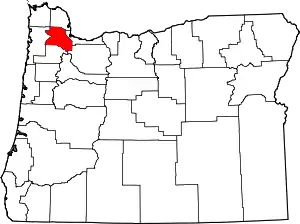Sherwood, Oregon
Sherwood is a city in Washington County, Oregon, United States. Located in the southeast corner of the county, it is a residential community in the Tualatin Valley, southwest of Portland. As of the 2010 census, Sherwood had a population of 18,194 residents. The city's population for 2019 was estimated to be 19,879 by the U.S. Census.[6] Sherwood was first incorporated in 1893 as a town. Originally named Smockville after its founder, James Christopher Smock, the town was given its current name by local businessman Robert Alexander in 1891, who likely named it after his hometown of Sherwood, Michigan.
Sherwood, Oregon | |
|---|---|
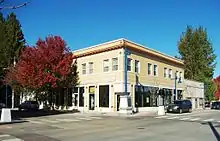 Building in downtown | |
| Nickname(s): Smockville | |
| Motto(s): Home of the Tualatin River National Wildlife Refuge | |
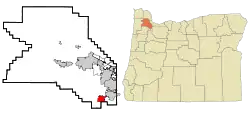 Location in Oregon | |
| Coordinates: 45°21′25″N 122°50′36″W | |
| Country | United States |
| State | Oregon |
| County | Washington |
| Incorporated | 1893 |
| Government | |
| • Type | Council-manager |
| • Mayor | Keith Mays [1] |
| Area | |
| • Total | 4.61 sq mi (11.95 km2) |
| • Land | 4.61 sq mi (11.95 km2) |
| • Water | 0.00 sq mi (0.00 km2) |
| Elevation | 193 ft (59 m) |
| Population | |
| • Total | 18,194 |
| • Estimate (2019)[4] | 19,879 |
| • Density | 4,309.34/sq mi (1,663.72/km2) |
| Time zone | UTC−8 (Pacific) |
| • Summer (DST) | UTC−7 (Pacific) |
| ZIP code | 97140 |
| Area code(s) | 503, 971 |
| FIPS code | 41-67100[3] |
| GNIS feature ID | 1126877[5] |
| Website | www.ci.sherwood.or.us |
History
What is now the Sherwood area was originally inhabited by the Atfalati band of the Kalapuya nation. Native Americans were relocated to reservations after the Donation Land Claim Act of 1850–55 gave American citizens exclusive ownership of these lands. The relocation process took place under the guidance of a series of federal employees, most notably Superintendent of Indian Affairs Joel Palmer, who was removed from office after being criticized for being too lenient with Indian policy.[7]
The California Gold Rush of 1849 caused a dramatic shift in the area's economy. Oregon City, Oregon is along a stretch of the Willamette River that had always been attractive to trade since prehistoric times, when trading activity was dominated by the Chinookan tribe. When settlers of European extraction began arriving in large numbers, Oregon City became (arguably) the "End of the Oregon Trail". After the Gold Rush, however, Portland, Oregon, replaced Oregon City as the area's most important center of trade and commerce. Sherwood is within 20 miles (32 km) of both cities.

The name "Sherwood" arose from a declination of naming the town "Smock Ville" after its co-founders James Christopher and Mary Ellen Smock. In 1885, the Smocks gave a right-of-way on their property to the Portland and Willamette Valley Railway. The Smocks platted the town in 1889, the same year rail service began. Tradition has it that no one, not even the town's founders, liked the name "Smock Ville," and so a public meeting was held to rename the town.[8] Robert Alexander, who was both a local resident and prominent businessman, suggested the name "Sherwood." According to post office records, Alexander was from Sherwood, Michigan,[9] and also said the forest which surrounded the city was like Sherwood Forest in England. The U.S. Postal Department began sending mail to the Town of Sherwood, Oregon on July 5, 1891. Smock was the first postmaster. The Town of Sherwood was incorporated under Oregon Senate Bill 36 in 1893.[10][11]
The main industry in the 1890s was a pressed brick yard which closed in 1896, a victim of the deep recession of 1893.[12] The Klondike Gold Rush of 1897 revived Sherwood's economy. In 2013, Money ranked Sherwood fifth among the top fifty best places to live in the United States.[13] In August 2009, Family Circle named the city one of America's most "family friendly" small towns.
The population of the city in 1911 was 350 within a 1-square-mile (2.6 km2) city limit. The city has since expanded to nearly 4.5 square miles (12 km2).[14]
Geography
According to the United States Census Bureau, the city has a total area of 4.31 square miles (11.16 km2), all land.[15]
| Climate data for Sherwood, Oregon | |||||||||||||
|---|---|---|---|---|---|---|---|---|---|---|---|---|---|
| Month | Jan | Feb | Mar | Apr | May | Jun | Jul | Aug | Sep | Oct | Nov | Dec | Year |
| Average high °F (°C) | 49 (9) |
53 (12) |
58 (14) |
63 (17) |
69 (21) |
75 (24) |
81 (27) |
81 (27) |
77 (25) |
65 (18) |
54 (12) |
47 (8) |
64 (18) |
| Average low °F (°C) | 35 (2) |
35 (2) |
38 (3) |
41 (5) |
46 (8) |
50 (10) |
54 (12) |
54 (12) |
50 (10) |
43 (6) |
38 (3) |
34 (1) |
43 (6) |
| Average precipitation inches (mm) | 6.11 (155) |
4.62 (117) |
4.06 (103) |
2.99 (76) |
2.29 (58) |
1.77 (45) |
.56 (14) |
.64 (16) |
1.39 (35) |
3.12 (79) |
6.36 (162) |
6.82 (173) |
40.73 (1,033) |
| Source: [16] | |||||||||||||
Demographics
| Historical population | |||
|---|---|---|---|
| Census | Pop. | %± | |
| 1900 | 111 | — | |
| 1910 | 115 | 3.6% | |
| 1920 | 320 | 178.3% | |
| 1930 | 382 | 19.4% | |
| 1940 | 447 | 17.0% | |
| 1950 | 575 | 28.6% | |
| 1960 | 680 | 18.3% | |
| 1970 | 1,396 | 105.3% | |
| 1980 | 2,386 | 70.9% | |
| 1990 | 3,093 | 29.6% | |
| 2000 | 11,791 | 281.2% | |
| 2010 | 18,194 | 54.3% | |
| 2019 (est.) | 19,879 | [4] | 9.3% |
| Sources:[3][17][18][19][20][21] | |||
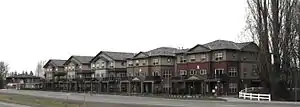
2010 census
As of the census of 2010, there were 18,194 people, 6,316 households, and 4,857 families living in the city. The population density was 4,221.3 inhabitants per square mile (1,629.9/km2). There were 6,569 housing units at an average density of 1,524.1 per square mile (588.5/km2). The racial makeup of the city was 88.5% White, 0.8% African American, 0.5% Native American, 3.5% Asian, 0.3% Pacific Islander, 2.7% from other races, and 3.7% from two or more races. Hispanic or Latino of any race were 7.0% of the population.[3]
There were 6,316 households, of which 49.6% had children under the age of 18 living with them, 63.5% were married couples living together, 9.7% had a female householder with no husband present, 3.6% had a male householder with no wife present, and 23.1% were non-families. 19.0% of all households were made up of individuals, and 6.7% had someone living alone who was 65 years of age or older. The average household size was 2.88 and the average family size was 3.31.[3]
The median age in the city was 34.3 years. 33.6% of residents were under the age of 18; 5% were between the ages of 18 and 24; 32.9% were from 25 to 44; 21.6% were from 45 to 64; and 6.8% were 65 years of age or older. The gender makeup of the city was 48.9% male and 51.1% female.[3]
The median income for a household in the city was $82,579, and the median income for a family was $90,492. Males had a median income of $66,052 versus $47,013 for females. The per capita income for the city was $31,047. About 2.2% of families and 4.1% of the population were below the poverty line, including 3.8% of those under age 18 and 1.0% of those age 65 or over.[3]
2000 census
As of the 2000 census, there were 11,791 people, 4,253 households, and 3,300 families living in the city. The population density was 2,895.5 people per square mile (1,118.6/km2). There were 4,412 housing units at an average density of 1,083.4 per square mile (418.5/km2). The racial makeup of the city was 92.36% White, 0.43% African American, 0.51% Native American, 2.22% Asian, 0.04% Pacific Islander, 1.76% from other races, and 2.67% from two or more ethnicity. Hispanic or Latino of any ethnicity were 4.72% of the population.[3]
There were 4,253 households, out of which 46.3% had children under the age of 18 living with them, 65.7% were married couples living together, 8.8% had a female householder with no husband present, and 22.4% were non-families. 17.0% of all households were made up of individuals, and 5.4% had someone living alone who was 65 years of age or older. The average household size was 2.77 and the average family size was 3.14.[3]
In the city, the population was spread out, with 31.7% under the age of 18, 5.5% from 18 to 24, 41.2% from 25 to 44, 16.4% from 45 to 64, and 5.3% who were 65 years of age or older. The median age was 31 years. For every 100 females, there were 95.4 males. For every 100 females age 18 and over, there were 92.9 males.[3]
The median income for a household in the city was $62,518, and the median income for a family was $67,277. Males had a median income of $47,920 versus $33,657 for females. The per capita income for the city was $25,793. About 1.5% of families and 2.7% of the population were below the poverty line, including 2.0% of those under age 18 and 11.7% of those age 65 or over.[3]
Infrastructure and services
Sherwood is within the Tri-County Metropolitan Transportation District of Oregon (TriMet),[22] the Portland metropolitan area's primary transit agency. TriMet bus lines 93, 94 and 97 provide service to Sherwood; line 94 is an express route running through to downtown Portland.[23] Additionally, the Yamhill County Transit Area's routes 44, 45x and 46s connect Sherwood with Newberg, McMinnville, and other points in Yamhill County,[24] which are outside the boundaries of the TriMet district.
Fire protection and emergency medical services are provided through Tualatin Valley Fire and Rescue.[25]
Schools
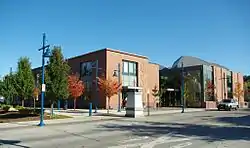
Sherwood has four elementary schools (J. Clyde Hopkins, Middleton, Archer Glen, Ridges), one middle school, Sherwood Middle School, and one high school, Sherwood High School, in the Sherwood School District. As of the 2017–2018 school year, there were between 500 and 600 students attending each of the four elementary schools, 490 students at Laurel Ridge Middle School, 686 at Sherwood Middle School, and 1,712 students enrolled at Sherwood High School.[26] The Sherwood School District also sponsors a program for at-risk youth in high school, and has an alternative school for teens having problems with the abuse of drugs or alcohol, and also caters to students in trouble with law enforcement. Within the confines of the city, there is also a private grade-school, a public charter k-8 school (Sherwood Charter School) as well as two private religious schools (St. Francis Catholic School and St. Paul Lutheran School).
Notable people
- Del Baker, former Major League Baseball player and manager
- Jim Benning, general manager of the Vancouver Canucks
- Dave Edstrom, former Olympic decathlete
- A.C. Gibbs, second Governor of Oregon
- Iain Harrison, competitive shooter
- Michael Jingozian, entrepreneur and political activist
- Glenn Olds, politician
- Jiggs Parrott, baseball player
- Thomas H. Parrott, musician
- Tom Parrott, baseball player
- Ilsa Paulson, former professional long-distance runner
- Bud Podbielan, baseball player
- Adley Rutschman, baseball player, #1 pick in the 2019 MLB draft
- Mark Smith, fantasy gamebook author
- Daniela Solís, soccer player
- Chuck Sun, former professional motocross racer
See also
References
- "Council Members | City of Sherwood Oregon". Retrieved January 25, 2018.
- "2019 U.S. Gazetteer Files". United States Census Bureau. Retrieved July 28, 2020.
- "U.S. Census website". United States Census Bureau. Retrieved 2012-12-21.
- "Population and Housing Unit Estimates". United States Census Bureau. May 24, 2020. Retrieved May 27, 2020.
- "US Board on Geographic Names". United States Geological Survey. 2007-10-25. Retrieved 2008-01-31.
- "Population and Housing Unit Estimates". Retrieved May 21, 2020.
- "Notable Oregonians: Joel Palmer- Pioneer/Writer". Oregon Blue Book. Oregon Secretary of State. Retrieved April 7, 2018.
- Sherk, Ronald (1936). Clyde List (ed.). "History of Sherwood Oregon - Graduation Thesis for Pacific College". Newberg, Oregon. Sherwood Historical Society. Archived from the original on September 26, 2017. Retrieved April 7, 2018.
- Engeman, Richard H. "The Oregon Companion: An Historical Gazetteer of the Useful, the Curious, and the Arcane" Timber Press, 2009, p. 341
- Legislative Assembly (1893). Journal of the Senate. 17th Regular Session. State of Oregon. pp. 38, 94, 117, 121, 122, 501, 529, 537. Retrieved April 7, 2018.
- "Oregon Senate Bill 36 (text of)". 1893. Archived from the original on February 20, 2016.
- "Archived copy". Archived from the original on 2009-04-27. Retrieved 2009-10-05.CS1 maint: archived copy as title (link)
- "Best Places to Live 2013". Money. Time. 2013. Retrieved 2015-04-11.
- "City History". City of Sherwood. Retrieved 2015-04-11.
- "US Gazetteer files 2010". United States Census Bureau. Archived from the original on 2012-01-25. Retrieved 2012-12-21.
- "Monthly Averages for Sherwood, OR (97140)". Weather.com. Retrieved March 19, 2012.
- "Population-Oregon" (PDF). U.S. Census 1910. U.S. Census Bureau. Retrieved 2013-11-22.
- "Population-Oregon" (PDF). 15th Census of the United States. U.S. Census Bureau. Retrieved 2013-11-27.
- "Number of Inhabitants: Oregon" (PDF). 18th Census of the United States. U.S. Census Bureau. Retrieved 2013-11-22.
- "Oregon: Population and Housing Unit Counts" (PDF). U.S. Census Bureau. 1990. Retrieved 2013-11-22.
- "Incorporated Places and Minor Civil Divisions Datasets: Subcounty Population Estimates: April 1, 2010 to July 1, 2012". U.S. Census Bureau. Archived from the original on June 11, 2013. Retrieved 2013-11-25.
- Redden, Jim (June 24, 2015). "TriMet moves to raise payroll tax to expand regional service". Portland Tribune. Retrieved 2018-04-07.
- "94-Pacific Hwy/Sherwood". TriMet. Retrieved 2018-04-07.
- "Routes 44 & 45x; Route 46s" (PDF). Yamhill County Transit Area. Retrieved 2018-04-07.
- "About TVF&R". Tualatin Valley Fire & Rescue. Retrieved 2018-04-08.
- "Fast Facts". Sherwood Schools. Sherwood School District 88J. Retrieved 20 November 2017.
External links
| Wikimedia Commons has media related to Sherwood, Oregon. |
